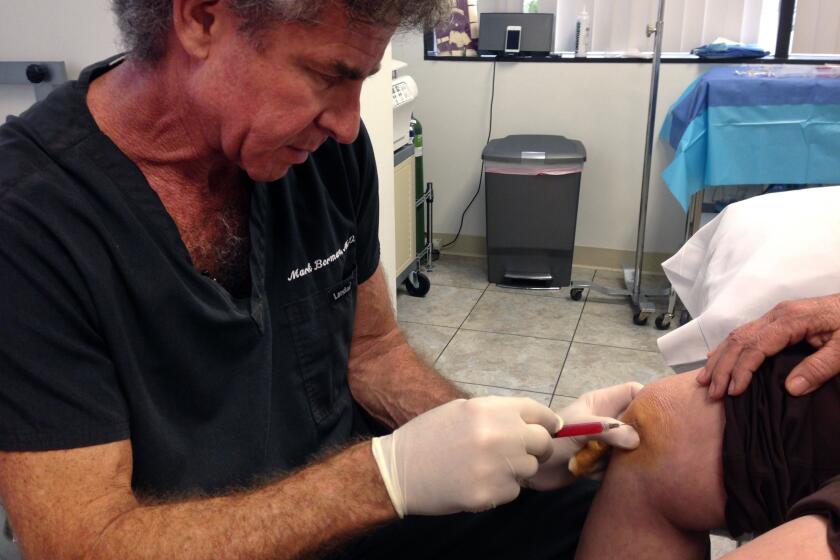Greyhound Faces an Uphill Climb : Transportation: The U.S.’ only cross-country bus line is sprucing up its stations and trying to improve service. But ridership is the key to profits--and survival.
It was not so much the pastel color scheme or the swaying palm trees that most impressed Angie Sims about the new Greyhound bus terminal in downtown Los Angeles.
“This is normal,” said Sims, a 29-year-old bartender from Fontana, as she and her 3-year-old daughter munched on bus terminal tacos. In contrast, she described the old terminal as a “crazy place” filled with dirty bathrooms, drug dealers and street people.
“This is much, much cleaner,” Sims said. And, she proclaimed after finishing her meal, “the food is better too.”
The pleasant surroundings and consistent service that travelers such as Sims want are some of the basics that Greyhound Lines has embraced as the nation’s largest intercity bus carrier tries to rebuild a business emerging from bankruptcy proceedings and a bloody labor dispute.
But like an aging bus chugging up a hill, Greyhound and other intercity carriers face an arduous struggle to carve out a place for themselves in the age of the auto and airplane, transportation observers say. So far, buses have been losing the decades-long fight and transported only 2% of all long-distance travelers in 1990, according to the U.S Travel Data Center.
At Greyhound’s sparsely furnished headquarters in Dallas, executives are laying plans for life after 16 months under Chapter 11 bankruptcy protection from creditors. A federal bankruptcy judge, who earlier approved the company’s reorganization plan, on Thursday allowed the company to officially emerge from Chapter 11 as a publicly traded company with $165 million in debt. However, the National Labor Relations Board and the company’s drivers’ union--which struck the company last year--are appealing the decision.
Under the plan, Greyhound will attempt to offer higher levels of customer service and shift more of its business to routes of 200 miles or less between major cities.
Greyhound’s plight can be seen as a simple story of a company struggling for profits, but its situation also raises public policy questions that are increasingly troubling to many transportation experts.
Many worry that the big-city strategy means no long-distance transportation for millions of people who live in rural communities not served by train or airplane. They also worry that if Greyhound and other intercity carriers can’t make a profit, many more people in large and small communities who can least afford transportation--young itinerant workers, students and the elderly--will also be left without adequate service.
“I don’t think we can afford to lose that particular element, which provides mobility for two very important groups (the young and elderly) in our society,” said Milton Glisson, head of the Transportation Institute at North Carolina Agricultural and Technical State University. “I’m not sure what the bus industry is going to do. The national bus industry is in for a tough period.”
Buses are basically the carrier of last resort for those who have no access to other forms of transportation, said Michael Redisch, an official with the Interstate Commerce Commission, which oversees interstate bus service. “There are public benefits even though it doesn’t show up in profits,” he said.
Although public policy-makers bemoan the loss of intercity bus service, very little in the way of public funds have gone into the system. In contrast, the travelers on trains and planes enjoy larger direct and indirect federal subsidies than their less affluent counterparts on buses.
Amtrak, for example, received $540 million in federal subsidies during fiscal 1991 but carries about half as many long-distance travelers.
The intercity bus industry “has historically been the least subsidized,” said Frank Mulvey, assistant director for transportation issues at the General Accounting Office, the investigative arm of Congress that is studying the impact of declining intercity bus service on rural communities and how state governments have responded.
Yet, said Mulvey, “more places are served by bus than any other form of transportation.” Greyhound, the only remaining national bus company, has very little financial room to maneuver as it prepares to leave bankruptcy court and serve its customers.
The carrier must generate at least $40 million annually to refurbish and replace its aging bus fleet and must nurture a corporate culture devoted to delivering a high and consistent level of service. But all those new buses, terminals and attitudes must come without any substantial increase in the $36 average Greyhound fare.
The typical Greyhound passenger makes less than $31,000 a year and is extremely sensitive to price hikes, said Greyhound President and Chief Executive Frank J. Schmieder.
“We can’t go raising prices a whole lot,” said Schmieder, who has abandoned previous hopes of catering to more affluent travelers and business people. “They’ll just choose not to travel.”
Greyhound’s recent past has not helped its situation. Its profits and public image took a beating after the drivers’ strike--which remains unresolved--over wages played havoc with service nationwide. The NLRB is seeking to collect tens of millions of dollars in back pay for Greyhound drivers. The drivers were authorized by their union to return to work, but Greyhound balked at taking them back, saying it would force them to fire replacement drivers.
The strike and the carrier’s subsequent bankruptcy filing eroded confidence in the entire bus system.
“In the minds of most people in the country, Greyhound is synonymous with bus service, and so all the bad publicity has tarnished everybody’s business,” said Washington attorney Jeremy Kahn, who represents numerous regional bus lines.
Ridership on the nation’s 10 largest bus lines fell 21% in 1990 to 28.2 million from the previous year, while the group reported an annual loss of $112.9 million, according to the ICC.
Greyhound must also defend its safety record when press reports revealed that its accident rate rose 60% last year. Greyhound attributed the increase to the inexperience of drivers hired to replace strikers and said the rate has fallen as the new workers gained time behind the wheel. The company also implemented additional safety training for all its workers.
But Greyhound’s problems don’t end with safety concerns. Years of labor strife and disinterested upper management left the company with a work force and a corporate culture that paid little heed to high and consistent levels of customer service.
“It’s going to be one of the biggest challenges we have,” Schmieder said of efforts to boost customer service. Schmieder himself goes undercover in sweat shirts and work pants to ride buses and walk through terminals to check on service.
Offering a standard level of services without surprises would help retain its current passengers while building new business, Schmieder said. “You don’t like uncertainty when it comes to services, especially travel.”
Schmieder held out a glimmer of hope that some service would be restored to the thousands of rural outposts that were abandoned during the 1980s when deregulation of the industry forced bus companies to cut money-losing rural routes. About 80% of Greyhound’s current service, for example, is geared for urban travelers.
“We have probably abandoned towns that we shouldn’t,” Schmieder said.
But Greyhound, like other carriers, has decided that the road to long-term viability lies in frequent service on major highways between cities about 200 miles apart. The distance is long enough to persuade many people to leave their cars at home but short enough to put airline service at a disadvantage.
This strategy, however, may lead to the further erosion of rural service.
“The smaller towns and byways that are not on the major national highway system are probably going to be ones that are going to suffer more than other communities that are located closer to the interstate highway system,” Glisson said.
At the Los Angeles Greyhound terminal, it seemed as if travelers could get anywhere by bus. Destinations signs flashed “Dallas,” “Pismo Beach,” “Newhall” and “Tijuana/downtown” to a crowd of waiting passengers, many of whom carried belongings in cardboard boxes or plastic bags.
The new terminal got good marks in general, despite some opening-day confusion, a protest by strikers, and riders who complained of late buses and rude drivers.
“They all keep commenting on how clean it is,” said Chad Bridwell, a 35-year-old construction worker from Rapid City, S.D., who was on his way to San Diego to visit family. “And they all keep wondering how long it will last.”
While attacking its labor, financial and service problems, Greyhound still faces one daunting issue: Bus ridership has long been in decline and shows no sign of a turnaround.
Ridership has been falling for as long as automobile ownership has been on the rise. But the gradual decline turned into a free fall during the 1980s when the deregulation of the airline industry spawned numerous discount carriers, putting air travel for the first time within the reach of working-class people who traditionally traveled long distance by bus.
Federal transportation deregulation in the early 1980s also ended bus companies’ monopolies on certain routes and price protections, forcing many carriers to drop unprofitable routes. About 8,500 towns and cities receive regular bus service--down dramatically from the 15,000 communities served during the early 1970s, according to government and industry statistics.
In 1987, the shrinking market led Greyhound and Trailways--the nation’s only other cross-country bus line--to merge.
Getting Around
Buses lagged way behind airplanes and automobiles as the main form of travel in 1990
Automobile, truck, recreational vehicle: 79%
Airplane: 17%
Bus: 2%
Train: 1%
Other: 1%
* Statistics for trips of 100 miles or more Source: U.S. Travel Data Center
More to Read
Inside the business of entertainment
The Wide Shot brings you news, analysis and insights on everything from streaming wars to production — and what it all means for the future.
You may occasionally receive promotional content from the Los Angeles Times.










